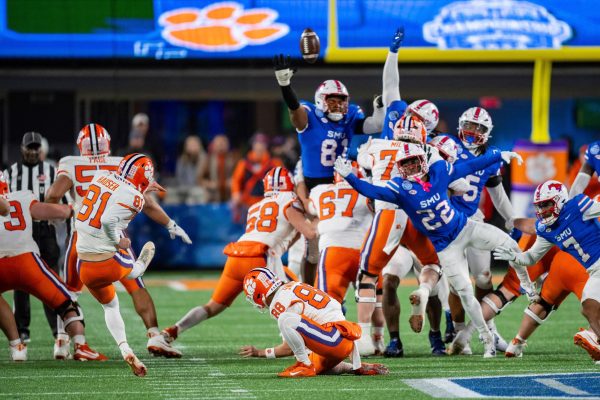Rivalries Going Out of Style
Roger Federer is a disgrace to his sport. He is polite, sportsmanlike and, worst of all, treats his arch-nemesis Rafael Nadal like they’re friends. The civility of this whole affair is absolutely suffocating and, frankly, it makes me want to vomit and then watch an informal NHL game; at least they get into real fights. Gone are the glory days when snide comments were volleyed between Andre Agassi and Pete Sampras and when John McEnroe’s scowl haunted officials’ nightmares. Unfortunately, we live in a passionless era of well-tailored tennis sweaters where the responsibility of inciting brutal brawls falls to the fans.
The story of Nadal and Federer reads rather like a French romance: lots of highly anticipated meetings, passionate engagements and an ultimately cordial, but distant relationship. Since their first meeting in 2004, the two men have faced off 21 times with Nadal winning 14 of the matches. Career-wise, Federer still holds the record of 16 Grand Slam titles. But, if you believe Sampras (stirring up the drama like a true champion), Nadal will shatter this record before he retires. Sampras went on to imply that besting Federer’s record wasn’t necessary, that Nadal had already proved his superiority over him. There was an opportunity for Federer to step up to the plate, to make some underhanded comment about Nadal’s mother, or to strut around and finally be a worthy role model for millions of children.
As much fun as it is to heap steaming piles of blame on Federer and Nadal, theirs is not the only sport suffering from anemic rivalries. There used to be a time when the Boston Red Sox and New York Yankees could not cross paths in the same train station without a fight breaking out. These days, Jorge Posada and David Ortiz can shoot ESPN commercials together. I trace this change back to the All-Star Game with its insidious plan of making sworn rivals teammates, if only for one night. This grotesque plot to destroy American traditions (fisticuffs and insults) began in 1933, two years before the end of Babe Ruth’s career and when the Sox-Yanks rivalry was at a blistering intensity. Coincidence, you wonder? No, I imagine not. Now, although some wonderful players have done their best to inject some passion into the hatred (thank you Pedro Martinez and Roger Clemens), most of the spitfire has been swirling between fans and, interestingly enough, football teams (we all remember the taunting chants of “Red Sox suck” during the NY Giants victory parade in 2008, right?).
Larry Bird and Magic Johnson certainly had the potential to create the greatest sports rivalry of all time. They were just too nice about it. The storyline was classic, as though a Hollywood producer had fashioned it out of melted-down Oscar statues. What were the purposes of the 1979 NCAA Championship loss that Bird and Indiana State suffered at the hand of Johnson and Michigan State and all those Celtics-Lakers NBA title game face-offs, if not to inspire a seething hatred between the two men? But, alas, our happy ending was doomed, sealed in amiability with a book, When the Game Was Ours, co-written by the duo and currently infecting the minds of youths with respectful integrity.
Where would women’s tennis be without the Williams sisters? Probably in a very unfashionable place where players don’t grunt every time they hit the ball. Rivalry between siblings is truly a sacred bond that goes back to the times of Cain and Abel and is best embraced when played out in front of millions of people and with millions of dollars in prize money and endorsement deals on the line. These two women, though not as open in their mutual resentment as would be admirable, are great emissaries of their sport and an inspiration to young women everywhere.
And so, with our athletes failing us, the task falls to the fans to re-inspire some teeth-gritting, fist-clenching dislike among today’s competitors. Examples of good-hearted brawls can be found in any sport. There are a few classic scenarios, though, which seem to always foster dynamic scenes. The ongoing feud between supporters of the Texas Longhorns and Oklahoma Sooners football teams, the Toronto Maple Leafs-Montreal Canadiens battle and the always exciting Manchester United-Liverpool derby are a few of my favorites.
Even in all this, as tennis lies like a rancid, reeking corpse in the gutter of competitive sports, a grassroots movement has begun to revitalize it back to its bloody glory. A few years ago, Christophe Fauviau was sent to prison after confessing to drugging the water bottles of his children’s tennis opponents, killing one. He is alleged to have poisoned players ranging from age 11 to 42 from 2000 to 2003. His most notable victim, Alexandre Lagardere, a 25-year-old elementary school teacher, died in a car crash when he fell asleep at the wheel after being poisoned by Fauviau during a match against Fauviau’s son. An inspiration, Monsieur Fauviau should serve as a model to parents and tennis hopefuls everywhere. If indeed Nadal and Federer cannot provide us with the rivalry we crave, then perhaps Fauviau could step into the limelight. Maybe he too could endorse a line of sports drinks. I’m thinking Powerade.





